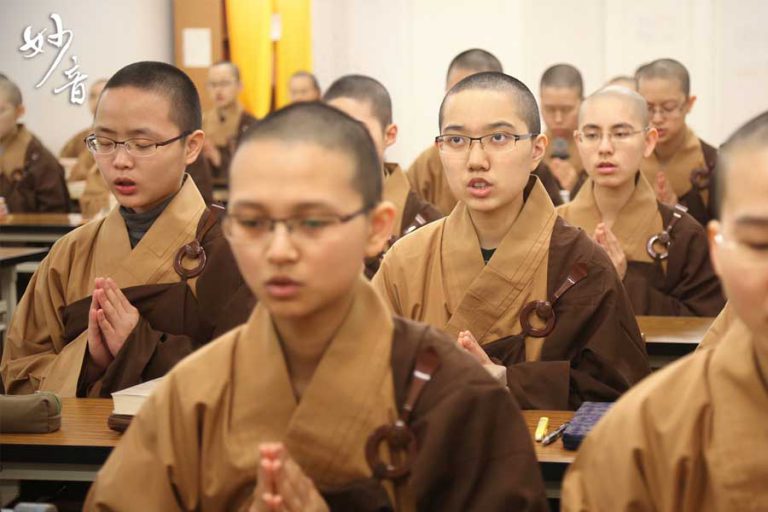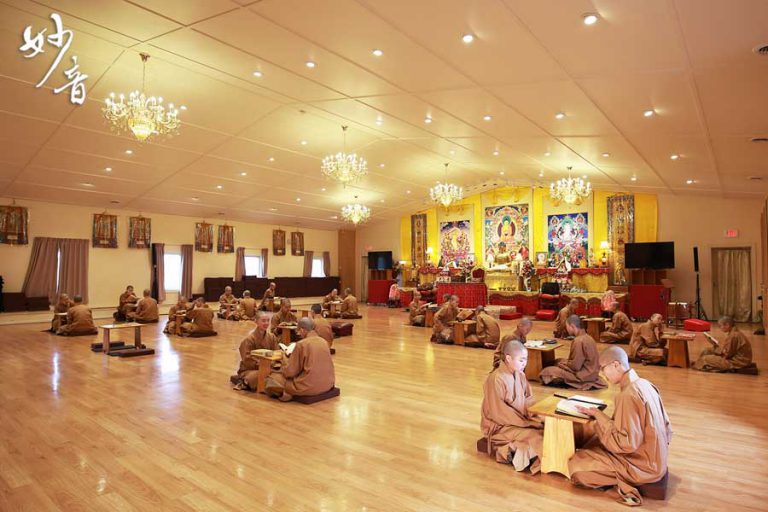Learning The Tripitaka: Sutras, Vinaya, Abhidharma
We believe that in order for us to achieve a complete understanding of Buddhism, we need to learn the Three Scriptures: Sutras are the words of the Buddha; Vinaya represents the rules and regulations of monastic life; Abhidharma is the interpretation of Buddhist doctrine.
GWBI’s core curriculum consists of The Great Treatise on the Stages of the Path to Enlightenment (The Great Treatise), Nanshan Vinaya, and The Five Great Treatises. The Great Treatise was composed by Great Master Lama Tsong-Kha-Pa, and it contains the core essence of Buddha’s teachings, drawing upon many sutras and abhidharma. Using the analogy of Abhidharma as our eyes and Vinaya as our legs –
a pair of eyes to clearly see the right path with a pair of strong and healthy legs – we are able to reach our goal of attaining complete happiness and leaving suffering behind.

The Sixteen-Year Five Great Treatises Curriculum: Recitation and Dialectics
The five major abhidharma are: Ornament for Clear Knowledge, Commentary on the Compendium of Valid Cognition, Commentary on the Middle Way, Treasury of Knowledge, and Compendium of Discipline. Completion of the sixteen-year Five Great Treatises curriculum is comparable to receiving a PhD in Buddhist philosophy. Each of the five abhidharmas is accompanied by numerous commentaries, all of which need to thoroughly comprehended. The curriculum is taught in the form of recitation and dialectics.
We believe that in order for us to achieve a complete understanding of Buddhism, we need to learn the Three Scriptures: Sutras are the words of the Buddha; Vinaya represents the rules and regulations of monastic life; Abhidharma is the interpretation of Buddhist doctrine.
GWBI’s core curriculum consists of The Great Treatise on the Stages of the Path to Enlightenment (The Great Treatise), Nanshan Vinaya, and The Five Great Treatises. The Great Treatise was composed by Great Master Lama Tsong-Kha-Pa, and it contains the core essence of Buddha’s teachings, drawing upon many sutras and abhidharma. Using the analogy of Abhidharma as our eyes and Vinaya as our legs –
a pair of eyes to clearly see the right path with a pair of strong and healthy legs – we are able to reach our goal of attaining complete happiness and leaving suffering behind.
Recitation, the ability to memorize texts word for word, not only improves one’s memory but also trains one’s mind to quiet down and concentrate.
There are many twenty-something-year-old novice nuns at Great Wisdom Buddhist Institute who have memorized over 400,000 words. This means they carry roughly 15 books in their heads wherever they go. Reciting aloud all that has been memorized requires three full days with no breaks in between.

Dialectics is the skill of debate through logical reasoning. It develops the mind’s ability to reason logically and deepen one’s understanding of what has been learned.
By strengthening our logical reasoning skills over time, we find ourselves less and less dictated by our emotions in stressful situations. Instead of simply reacting to the situation and succumbing to the negative emotions, we start to have a clearer mind and see the situation from different angles.
The novice nuns who are currently learning The Five Great Treatises have also been learning Classical Chinese from a young age. We hope that pairing deep understanding of the Buddhist teachings as well as the ability to express in exquisite classical language would aid in the translation of Buddhist scriptures, thereby preserving and increasing awareness of these teachings. Moreover, with a strong foundation in scriptural knowledge, we can further our practice by engaging in meditation retreats guided by our teachers. We aspire to become practitioners skilled in both scriptural and experiential knowledge so we can help everyone find joy in their lives.
